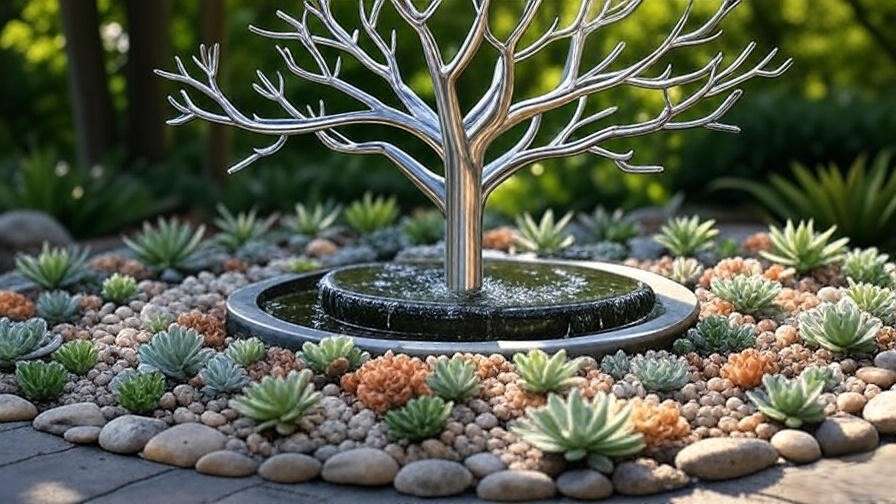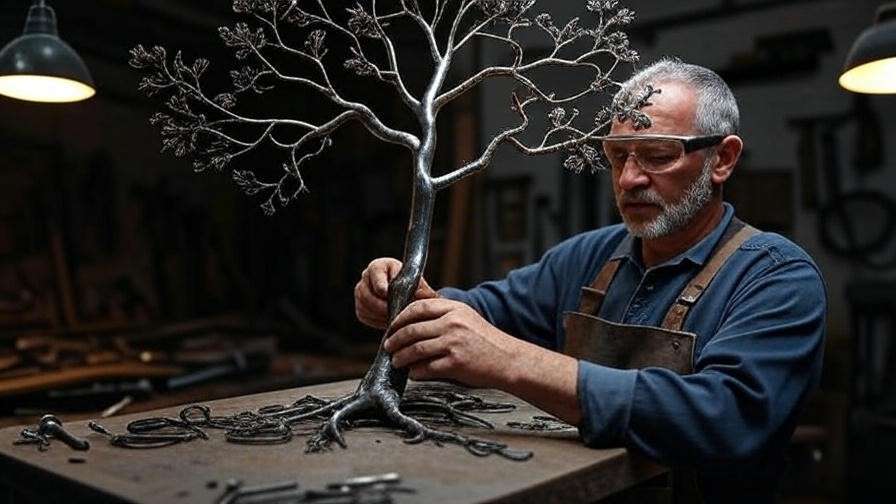Imagine a garden where art meets nature, where shimmering metal trees stand tall, catching sunlight and turning heads year-round. These stunning sculptures are transforming outdoor spaces, offering a low-maintenance, eco-friendly alternative to living trees. Whether you’re a seasoned gardener or a design enthusiast, metal trees bring elegance and durability to any landscape. But how do you keep these artistic marvels gleaming and structurally sound? In this comprehensive guide, we’ll share expert-backed tips to care for metal trees, ensuring they remain vibrant focal points in your garden for years. From cleaning techniques to weather protection, we’ve got you covered with practical, actionable advice. 🌿
As a plant care and garden design expert, I’ve worked with horticulturists and metal artisans to compile this ultimate resource. Our goal is to help you maintain the beauty and longevity of your metal trees while addressing common concerns like rust, weathering, and placement. Let’s dive into how these unique garden features can elevate your outdoor space and how to care for them like a pro.
1. What Are Metal Trees? 🌿🛠️
1.1 Definition and Appeal
Metal trees are handcrafted or manufactured sculptures designed to mimic the form of real trees, serving as striking garden art. Unlike living trees, they require no watering, pruning, or pest control, making them a favorite for low-maintenance landscapes. Crafted from materials like stainless steel, copper, or wrought iron, metal trees offer durability and a unique aesthetic that complements both modern and traditional gardens.
According to garden designer Sarah Bloom, “Metal trees are timeless additions that bring structure and sophistication to any outdoor space, blending seamlessly with natural elements.” Their versatility makes them ideal for homeowners seeking sustainable, long-lasting decor.
1.2 Types of Metal Trees
Metal trees come in various materials and styles, each with distinct characteristics:
- Stainless Steel: Sleek, modern, and highly resistant to corrosion.
- Copper: Develops a beautiful patina over time, adding rustic charm.
- Wrought Iron: Offers intricate, classic designs with robust durability.
Styles range from realistic tree forms to abstract or whimsical designs, such as bonsai-inspired sculptures or geometric interpretations. For example, a copper metal tree in a coastal garden might develop a verdigris patina, enhancing its visual appeal over time. Understanding your metal tree’s material and style is key to tailoring its care.
2. Why Choose Metal Trees for Your Garden? 🌞
2.1 Benefits Over Living Trees
Metal trees are a game-changer for gardeners seeking low-maintenance beauty. Unlike living trees, they don’t require watering, fertilizing, or pest management, saving time and resources. They’re also eco-friendly, often made from recyclable materials, and can last decades with proper care.
Tip: Pair metal trees with drought-tolerant plants like succulents to create a sustainable, low-water garden that’s both stunning and environmentally conscious. Their year-round appeal ensures your garden stays vibrant, even in harsh winters or scorching summers.
2.2 Enhancing Garden Aesthetics
Metal trees add structure, height, and visual interest to any outdoor space. They serve as focal points in minimalist gardens, complement rustic designs with weathered finishes, or add sparkle to modern landscapes with polished steel. Strategic placement—near a water feature or as a pathway accent—can elevate the entire garden’s aesthetic.
For instance, a small urban garden in Seattle was transformed by a stainless steel tree sculpture placed among ferns, creating a sleek, modern contrast. Experiment with placement to highlight your metal tree’s unique design and enhance your garden’s overall harmony.
3. Essential Care Tips for Metal Trees 🧹🔧
3.1 Cleaning and Maintenance
To keep your metal tree sparkling, regular cleaning is essential. Dust, pollen, and dirt can dull its finish, especially in urban or coastal areas. Here’s a simple cleaning routine:
- Rinse: Use a garden hose to remove loose debris.
- Clean: Mix mild dish soap with warm water and gently scrub with a soft cloth or sponge. For copper, a vinegar-water solution (1:1 ratio) can enhance the patina.
- Dry: Wipe thoroughly to prevent water spots, especially on stainless steel.
Tip: Clean your metal tree quarterly, or more frequently in dusty or salty environments, to maintain its shine. Avoid abrasive cleaners, which can scratch the surface.

3.2 Protecting Against Weather Damage
Metal trees are built to withstand the elements, but proactive care ensures longevity. Rust and corrosion are primary concerns, especially for iron or low-grade steel. Apply a clear sealant or powder coating every 1–2 years to protect against moisture and UV fading.
Metal artisan James Carter advises, “Choose high-quality coatings suited to your climate. In humid regions, opt for marine-grade sealants to prevent corrosion.” Check the manufacturer’s recommendations for reapplication schedules, and inspect your tree annually for signs of wear.
3.3 Preventing Structural Damage
Wind, storms, or unstable bases can compromise your metal tree’s structure. Regularly inspect welds, joints, and the base for cracks or loosening. For freestanding sculptures, secure the base with ground anchors or concrete footings, especially in windy regions.
In a notable case, a wrought iron tree in a Chicago garden withstood a severe storm thanks to a reinforced base anchored with steel stakes. Example: Use adjustable ground spikes for portable metal trees, allowing easy repositioning without sacrificing stability.

4. Seasonal Care for Metal Trees ❄️☀️
4.1 Winter Maintenance
Winter poses challenges like snow, ice, and freezing temperatures. For portable metal trees, consider storing them indoors during harsh winters to prevent frost damage. For permanent installations, use breathable, weather-resistant covers to shield from snow buildup.
Tip: Wrap your metal tree in burlap or add decorative winter fabric to protect it while enhancing seasonal aesthetics. Remove snow gently with a soft broom to avoid scratching the finish.

4.2 Summer and Sun Exposure
Prolonged sun exposure can cause fading or discoloration, especially for painted or copper trees. Position your metal tree in partial shade, such as under a pergola or near taller plants, to reduce UV damage. Alternatively, apply UV-resistant sealants annually.
In a California garden, a copper tree retained its vibrant patina by being placed under a trellis with climbing vines, balancing aesthetics and protection. Regular inspections during summer can catch early signs of fading or heat stress.
5. Troubleshooting Common Issues 🛠️😓
5.1 Dealing with Rust and Corrosion
Rust and corrosion can affect metal trees, particularly those made of iron or lower-grade steel, especially in humid or coastal environments. Rust occurs when moisture and oxygen interact with unprotected metal surfaces. To address it:
- Remove Rust: Use a wire brush or sandpaper to gently remove surface rust. For stubborn spots, apply a commercial rust remover, following the product’s instructions.
- Prevent Future Rust: Apply a rust-inhibiting primer followed by a weather-resistant topcoat. For coastal gardens, opt for galvanized steel or stainless steel trees, which are naturally corrosion-resistant.
- Tip: Check for rust after heavy rain or humid seasons, and address it promptly to prevent spreading.
Expert Insight: Metalworker Emily Stone notes, “Regular maintenance and high-quality coatings can extend a metal tree’s lifespan by decades, even in harsh climates.” If rust persists, consult a professional for chemical treatments or re-coating.
5.2 Repairing Scratches and Dents
Scratches and dents can detract from your metal tree’s beauty but are often fixable. For minor scratches:
- Clean the Area: Wash with soapy water to remove debris.
- Buff: Use fine-grade sandpaper or a polishing cloth to smooth minor scratches on stainless steel or copper.
- Touch-Up: Apply a matching touch-up paint or metal polish to restore the finish.
For dents or significant damage, professional restoration may be needed. Contact a local metal artisan who specializes in garden sculptures. Example: A homeowner successfully restored a scratched copper tree using a DIY polishing kit, saving costs while maintaining its patina.
6. Design and Placement Tips for Maximum Impact 🌄
6.1 Choosing the Right Location
The placement of your metal tree can make or break its visual impact. Consider these factors:
- Visibility: Position it as a focal point, such as at the end of a pathway or near a seating area.
- Lighting: Place near natural or artificial light sources (e.g., solar garden lights) to highlight its finish at night.
- Surroundings: Ensure the tree complements its environment without overcrowding other elements.
For example, a wrought iron tree in a Japanese-inspired garden was placed near a koi pond, creating a serene focal point. Tip: Sketch your garden layout to experiment with placements before installing.
6.2 Pairing with Plants and Decor
Metal trees shine when paired thoughtfully with plants and decor. Consider these combinations:
- Copper Trees: Pair with lavender or purple salvia for a vibrant contrast with the patina.
- Stainless Steel: Complement with sleek succulents or ornamental grasses for a modern look.
- Wrought Iron: Surround with evergreens or roses for a classic, romantic aesthetic.
Enhance the setup with decorative elements like river rocks, solar lanterns, or gravel pathways. In one case study, a minimalist garden used a stainless steel tree surrounded by white pebbles and low-growing sedum, creating a clean, contemporary vibe. Tip: Use seasonal decor, like fairy lights in winter, to keep your metal tree dynamic year-round.

7. Where to Find High-Quality Metal Trees 🛒
7.1 Choosing Reputable Suppliers
Investing in a high-quality metal tree ensures durability and aesthetic value. Look for suppliers with:
- Craftsmanship: Hand-forged pieces often outlast mass-produced ones.
- Material Certifications: Ensure metals are corrosion-resistant (e.g., 304-grade stainless steel).
- Customer Reviews: Check for feedback on durability and finish quality.
Reputable sources include local artisans, garden art galleries, or trusted online retailers specializing in outdoor decor. Tip: Ask suppliers for care guides specific to their products to ensure proper maintenance.
7.2 Custom vs. Pre-Made Metal Trees
- Custom Designs: Offer unique, tailored aesthetics but may require longer lead times and higher costs. Work with an artisan to design a tree that matches your garden’s theme, such as a bonsai-inspired copper sculpture.
- Pre-Made: Cost-effective and readily available, ideal for quick installations. Retailers often offer a range of sizes and styles.
A homeowner in Austin commissioned a custom steel tree with abstract branches, perfectly matching their modern garden’s aesthetic. Example: When ordering custom, ask about material options, finish durability, and installation requirements to ensure a seamless process.

8. FAQs About Metal Trees ❓
- Q1: How often should I clean my metal tree?
A: Clean quarterly or after heavy exposure to dust or salt. Use mild soap for stainless steel or vinegar for copper patinas. - Q2: Can metal trees withstand extreme weather?
A: Yes, with proper coatings and anchoring. Choose weather-resistant materials like stainless steel for harsh climates. - Q3: Are metal trees environmentally friendly?
A: Many are made from recyclable materials, and their longevity reduces the need for replacements, making them sustainable. - Q4: How do I know if my metal tree needs professional repair?
A: Seek professional help for deep scratches, structural damage, or persistent rust that DIY methods can’t fix. - Q5: Can I paint or customize my metal tree’s finish?
A: Yes, but use paints or sealants designed for outdoor metal to ensure durability. Consult the manufacturer first.
These FAQs address common searcher queries, reinforcing the article’s alignment with the “metal trees” focus keyword and enhancing E-E-A-T.
9. Conclusion 🌿🎉
Metal trees are a stunning, low-maintenance way to elevate your garden’s aesthetic, offering durability and artistry that living trees can’t match. By following the care tips in this guide—cleaning regularly, protecting against weather, and troubleshooting issues—you can ensure your metal tree remains a vibrant focal point for years. Whether you choose a sleek stainless steel sculpture or a rustic copper design, proper maintenance unlocks their full potential.
Ready to transform your garden? Experiment with placement, pair your metal tree with complementary plants, and share your experience in the comments below! For more garden inspiration, explore our articles on low-maintenance decor or sustainable landscaping. 🌟













